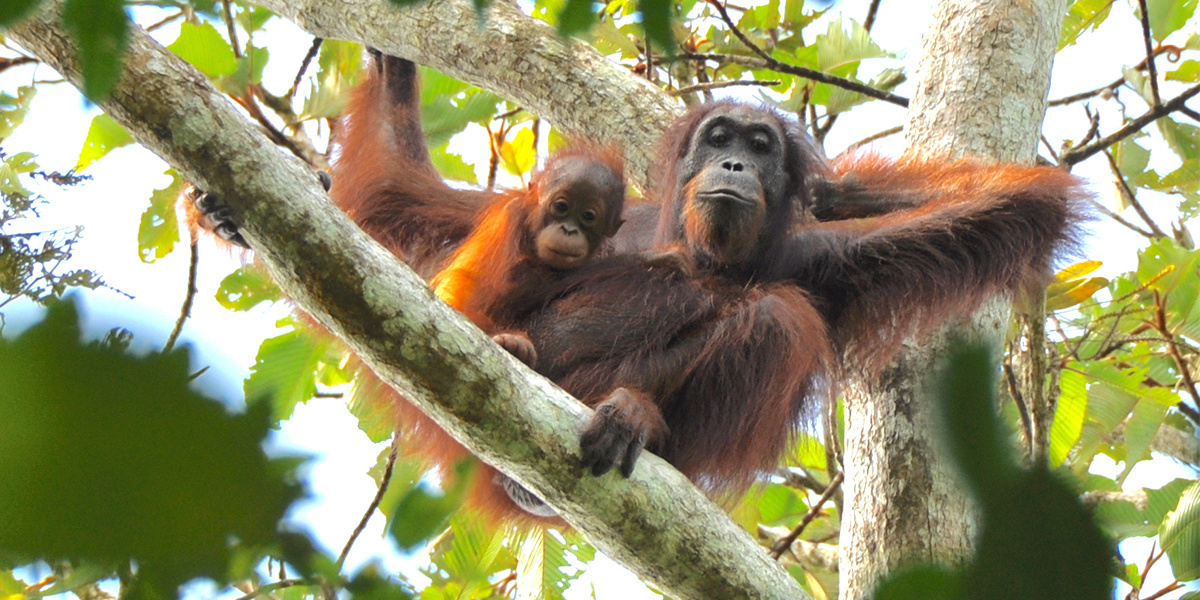
Ravaged by Deforestation, Borneo Loses Nearly 150,000 Orangutans in 16 Years

By Basten Gokkon
The world lost nearly 150,000 orangutans from the island of Borneo in the past 16 years due to habitat loss and killing, and is on track to lose another 45,000 by 2050, according to a new paper in the journal Current Biology.
The study, published Feb. 15, observed 36,555 orangutan nests across Borneo, an island that is shared between Indonesia, Malaysia and Brunei, between 1999 and 2015. During that period, the researchers reported a steep decline in the number of nests they encountered over a given distance: the encounter rate more than halved from 22.5 nests per kilometer (about 36 per mile) to 10.1 nests per kilometer. That decline, they calculate, represents an estimated loss of 148,500 individual Bornean orangutans (Pongo pygmaeus).
The data also suggested that only 38 of the 64 identified spatially separated groups of orangutans, known as metapopulations, now include more than 100 individuals, which is the accepted lower limit to be considered viable.
“They are disappearing even faster than researchers had envisaged,” said Maria Voigt, a researcher at the Max Planck Institute for Evolutionary Anthropology in Germany and lead author of the new study.
“The major causes are habitat degradation and loss in response to local to global demand for natural resources, including timber and agricultural products, but very likely also direct killing,” Voigt wrote.
Forest and oil palm plantation in BorneoPhoto courtesy of Dr. Marc Ancrenaz
Some 288,500 orangutans were believed to live in Borneo in 1973, when three-quarters of the island was still covered with forest. By 2012, the number had dropped to an estimated 104,700 individuals, according to the IUCN.
Within that nearly four-decade span, more than a third of Borneo’s rainforests was destroyed due to fire, logging, mining and the proliferation of plantations, particularly oil palms. The scale of the deforestation had a severe impact on the population of the island’s orangutans, the largest arboreal animal.
“The decline in population density was most severe in areas that were deforested or transformed for industrial agriculture, as orangutans struggle to live outside forest areas,” Voigt said.
The study found rates of orangutan decline were highest—63 to 75 percent–in areas deforested or converted to plantations in both Kalimantan, the Indonesian portion of the island, and the Malaysian state of Sabah. Conversely, there were almost no industrial plantations and deforested areas within the orangutan metapopulation range in Sarawak.
“Worryingly, however, the largest number of orangutans were lost from areas that remained forested during the study period,” Voigt said.
The loss of orangutans in untouched, or “primary,” and selectively logged forests, where the majority of orangutans occur, accounted for 67 percent of the total estimated loss in Borneo between 1999 and 2015. Voigt suggested “a large role of killing” as the main cause for the population decline in these areas, particularly in the absence of plausible alternative explanations, such as infectious diseases of the type observed among African apes.
Last August, the Indonesian government reported that four-fifths of 57,350 wild orangutans in Kalimantan lived outside national parks and other protected areas, leaving them exposed to poaching and conflicts with humans.
“People kill orangutans for their meat, as they hunt other edible species,” Voigt said. “Orangutans are also killed when their young are captured for the pet trade.”
But some of these killings are also intertwined with deforestation and logging, Voigt noted.
“People on Borneo kill orangutans out of conflict-situations, when the animals are pushed into entering gardens or plantations because their habitat has been destroyed,” she said.
“With the increasing development and the resulting deforestation and conversion the interface between wildlife and humans increases, the number of the humans increases and the habitat that is left for orangutan decreases,” she added.
Voigt said the study provided only a small snapshot of orangutan-human interactions on Borneo.
Two orangutans were reported killed so far this year in Central Kalimantan and East Kalimantan provinces. Indonesia made global headlines in 2011 when at least 20 orangutans were slaughtered by plantation workers in East Kalimantan under the guise of “pest control.”
Voigt’s study projects a further loss of at least 45,300 orangutans by 2050, based solely on the direct consequence of habitat loss.
If current deforestation rates hold, some 215,000 square kilometers (83,000 square miles) of forest in Borneo will have been lost between 2007 and 2020, reducing the remaining forest cover to 24 percent, according to a 2012 study by the WWF.
Voigt said her team’s findings highlighted the need for a shift in efforts to protect orangutans in Borneo, including habitat conservation and measures to combat the illegal killing.
“This is something that our report could confirm. That even if there is forest, the orangutans are disappearing and more conservation measures are necessary, such as awareness raising, education, support in conflict situations for local communities, law enforcement,” she said.
“With most orangutans living outside protected areas, it means we need to get on board the people who manage these areas, i.e. communities and companies.”
The Roundtable on Sustainable Palm Oil (RSPO) and the Forest Stewardship Council (FSC) are examples of certification schemes that incentivize these partnerships, by enabling consumers to favor responsible natural resource management.
The Indonesian government in 2016 declared a five-year moratorium on new licenses to establish oil palm plantations across the archipelago. The policy also included revoking forest release permits for the period 2015-2016.
“Our findings are alarming,” Voigt said. “To prevent further decline and continued local extinctions of orangutans, humanity must act now: biodiversity conservation needs to permeate into all political and societal sectors and must become a guiding principle in the public discourse and in political decision making processes.”
Top 25 Most Endangered Primates: the Most Current List https://t.co/IPIr8ICAJa @ImageOfWildlife @JaneGoodallInst
— EcoWatch (@EcoWatch) November 30, 2017
Reposted with permission from our media associate Mongabay.

 233k
233k  41k
41k  Subscribe
Subscribe 
